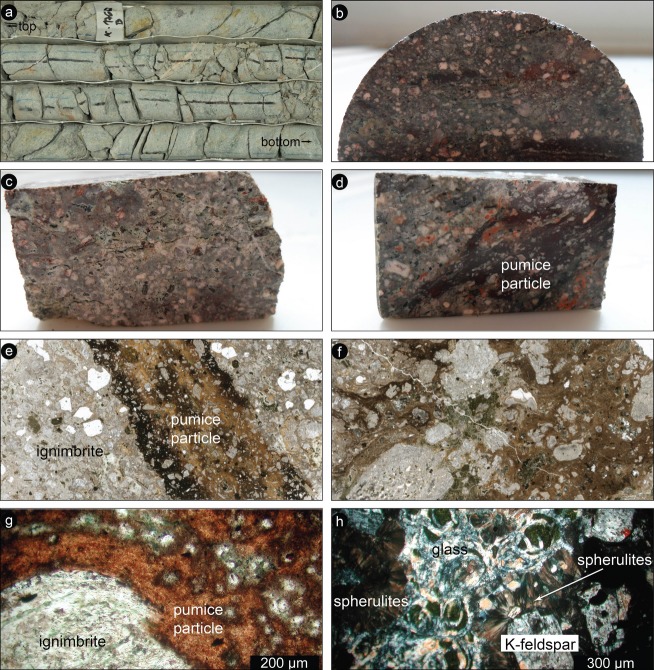Fig. 15.
Interval 423–517 mblb: Rhyodacitic ignimbrite. a) Box containing part of the core run 176 (approximately 507–510 mblb). The core width is 6 cm. The core consists of an apparently homogenous greenish ignimbrite, crosscut by fractures and whitish veins filled by both carbonates and zeolites. Fractures and veins are developed with an angle between 15 and 45° with respect to the core axis. b) Cross section of a large pumice clast in the ignimbrite, cut parallel to the flow plane. Note the blackish glassy matrix and the abundant equigranular mineral grains. Sample 6 cm wide. Sample 147Q2-W40-41 (431.8 mblb). c) Pumice-free portion of the ignimbrite. Note the greenish glass preserved in the upper part of the sample. Sample 3 cm wide. Sample 162Q5-W24-26 (470 mblb). d) Ignimbrite containing a large flattened pumice inclusion. Sample is 3 cm wide. Sample 173Q5-W25-27 (501.3 mblb). e) Internal structure of a pumice particle in the ignimbrite. Note the darker color of the matrix and the more abundant feldspar grains at the contact with the host rock, forming the typical “chilled” margins. Thin section scan. Sample 149Q1-W26-28 (435.7 mblb). f) Internal structure of a large pumice particle, with a random distribution of feldspar grains and glass fragments (greenish) in a brownish matrix, characterized by a strong layering. Image width 3 cm. Thin section scan. Sample 164Q3-W35-37 (475.2 mblb). g) Detail of the contact between a pumice particle and host rock matrix. Sample 164Q3-W26-28 (475.1 mblb). Plane-polarized light microphotograph. h) Detail of strongly altered glass (chloritization or devitrification) preserved in the ignimbrite, with the characteristic perlitic fracturing. Note also the extensive development of spherulites at the margins of feldspar grains. Sample 148Q1-W20-30 (433.5 mblb). Cross-polarized light microphotograph.

